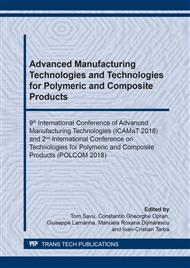[1]
R.A.C. Slater, Engineering and Plasticity: Theory and Application to Metal Forming Processes, (Macmillan International Higher Education LDT, London, 1977).
Google Scholar
[2]
T. Altan, A.E. Tekkaya, Sheet Metal Forming. Fundamentals, (ASM International, USA, 2012).
Google Scholar
[3]
https://www.ukessays.com/essays/engineering/modern-sheet-metal-forming-in-the-automotive-industry-engineering-essay.php, (accessed 25.08.2018).
Google Scholar
[4]
C. Cotigă, S.G. Racz, O. Bologa, R.E Breaz, Researches Regarding the Usage of Titanium Alloys in Cranial Implants, Innovative Manufacturing Engineering International Conference, (IManE 2014), Chişinău, Moldova, AMM 657, pp.173-177, (2014) 5] M. Bambach, B. Taleb Araghi, G. Hirt, Strategies to Improve the Geometric Accuracy in Asymmetric Single Point Incremental Forming, Prod Engineer Research Development 3, pp.145-156, (2009).
DOI: 10.4028/www.scientific.net/amm.657.173
Google Scholar
[6]
[J.L.P.B., Camara, Single Point Incremental Forming, Instituto Superior Tecnico, Dissertation, Universidade Tecnica de Lisboa, (2009).
DOI: 10.3940/rina.sm.1998.8
Google Scholar
[7]
J. Jeswiet, F. Micari, G. Hirt, A. Bramley, J. Duflou, Allwood Asymmetric Single Point Incremental Forming of Sheet Metal, Annals of CIRP 54(1), pp.623-650, (2005).
DOI: 10.1016/s0007-8506(07)60021-3
Google Scholar
[8]
E. Leszak, Apparatus and Process for Incremental Dieless Forming, USA patent no. US3342051A1, published (1967).
Google Scholar
[9]
H. Meier, C. Magnus, V. Smukala, Impact of superimposed pressure on dieless incremental sheet metal forming with two moving tools, CIRP Annals-Manuf Technology 60 p.327–330, (2011).
DOI: 10.1016/j.cirp.2011.03.134
Google Scholar
[10]
M.Z. Li, Z.Y. Cai, Z. Sui, Q.G. Yan, Multi-point forming technology for sheet metal, J Mater Process Tech, 129, pp.333-338, (2002).
DOI: 10.1016/s0924-0136(02)00685-4
Google Scholar
[11]
R.E. Breaz, O. Bologa, V. Oleksik, G. Racz, Computer Simulation for the Study of CNC Feed Drives Dynamic Behavior and Accuracy, The IEEE Region 8 EUROCON 2007, International Conference on Computer as a tool, Warsaw University of Technology, Warsaw, Poland, pp.2229-2233, (2007).
DOI: 10.1109/eurcon.2007.4400575
Google Scholar
[12]
G. Muresan, L. Morar, R.E. Breaz, Teaching CAM Techniques and CNC Programming in Technical Universities – An Integrated Approach, International Technology, Education and Development Conference INTED 2014, 10-12 March 2014, Valencia, Spain, 2014, pp.4115-4122.
Google Scholar
[13]
M. Inta, A. Muntean, P.D. Brindasu, Modeling and simulation in cutting of metal basis teaching, Quality management in higher education 2, pp.491-494, (2010).
Google Scholar
[14]
V. Oleksik, O.Bologa, R. Breaz, G. Racz, Comparison between the numerical simulations of incremental sheet forming and conventional stretch forming process, Int.J.MaterForm,1,pp.1187-1190, (2008).
DOI: 10.1007/s12289-008-0153-6
Google Scholar
[15]
G. Ingarao, G. Ambrogio, F. Gagliardi, R. Di Lorenzo, A sustainability point of view on sheet metal forming operations: material wasting and energy consumption in incremental forming and stamping processes, J Clean Prod 29, pp.255-268, (2012).
DOI: 10.1016/j.jclepro.2012.01.012
Google Scholar
[16]
M. Lovell, C. F. Higgs, P. Deshmukh, A. Mobley, Increasing formability in sheet metal stamping operations using environmentally friendly lubricants, J Mater Process Tech, 177(1), pp.87-90, (2006).
DOI: 10.1016/j.jmatprotec.2006.04.045
Google Scholar


